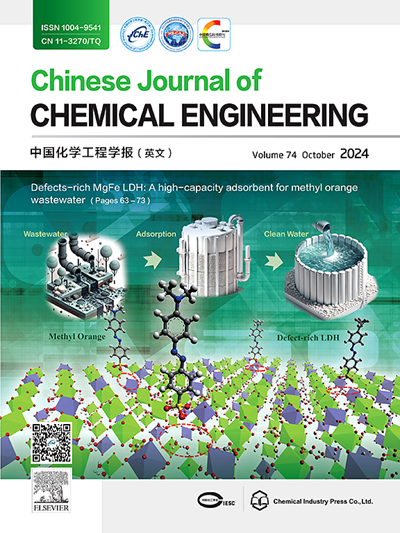Lower size limit of raw coal for efficient beneficiation in air-fluidized bed with magnetite particles
IF 3.7
3区 工程技术
Q2 ENGINEERING, CHEMICAL
引用次数: 0
Abstract
A feasible criterion was established to determine the lower size limit of raw coal (dpRm) for efficient beneficiation in the air-fluidized bed with magnetite particles. The feasibility of using small magnetite particles to accommodate the fine raw coal was demonstrated from the experimental perspective. The minimum size for the magnetite particles to be fluidized smoothly was clarified as 47.1 μm, which corresponded to the border between Geldart-B and -A groups. Since the gangue and coal components in the raw coal were crushed into the same size, dpRm depended on the greater one between dpGm (minimum size required for the gangue particles to sink towards the bottom) and dpCm (minimum size required for the coal particles to float towards the top). dpGm was determined as 259 μm by supposing that provided the gangue particles accumulated in the lower half bed, they could be potentially extracted from the bottom. On the other hand, it was observed that the coal particles could always accumulate in the upper half bed. Under such circumstances, dpCm was revealed as 9.8 μm since finer coal particles would be blown out by air before the 47.1 μm sized magnetite particles became fluidized. Eventually, dpRm was clarified as 259 μm, agreeing with the common view that raw coal coarser than 6 mm could be effectively beneficiated in the air-fluidized bed with magnetite particles. Additionally, the difficulty in beneficiating the fine raw coal was revealed to arise more from the remixing of sorted gangue particles than that of separated coal particles.

磁铁矿颗粒气流化床高效选矿原煤的粒度下限
为确定原煤在磁铁矿空气流化床中高效选矿的粒度下限,建立了可行的判据。从实验角度论证了利用小磁铁矿颗粒容纳细粒原煤的可行性。可以顺利流化的磁铁矿颗粒的最小尺寸为47.1 μm,对应于gel达特- b和-A基团之间的边界。由于原煤中的脉石和煤组分被粉碎成相同的粒度,因此dpRm取决于dpGm(脉石颗粒向底部下沉所需的最小粒度)和dpCm(煤颗粒向顶部漂浮所需的最小粒度)之间的较大的一个。假定脉石颗粒聚集在下半层,则有可能从底部提取,从而确定dpGm为259 μm。另一方面,观察到煤颗粒总是在上半层堆积。在这种情况下,由于在47.1 μm的磁铁矿颗粒流化之前,更细的煤颗粒会被空气吹出,因此dpCm为9.8 μm。最终确定的dpRm为259 μm,与一般认为含磁铁矿颗粒的空气流化床可以有效选别粗于6 mm的原煤的观点一致。此外,细粒原煤选矿的困难主要来自于分选矸石颗粒的再混,而不是分离出的煤颗粒的再混。
本文章由计算机程序翻译,如有差异,请以英文原文为准。
求助全文
约1分钟内获得全文
求助全文
来源期刊

Chinese Journal of Chemical Engineering
工程技术-工程:化工
CiteScore
6.60
自引率
5.30%
发文量
4309
审稿时长
31 days
期刊介绍:
The Chinese Journal of Chemical Engineering (Monthly, started in 1982) is the official journal of the Chemical Industry and Engineering Society of China and published by the Chemical Industry Press Co. Ltd. The aim of the journal is to develop the international exchange of scientific and technical information in the field of chemical engineering. It publishes original research papers that cover the major advancements and achievements in chemical engineering in China as well as some articles from overseas contributors.
The topics of journal include chemical engineering, chemical technology, biochemical engineering, energy and environmental engineering and other relevant fields. Papers are published on the basis of their relevance to theoretical research, practical application or potential uses in the industry as Research Papers, Communications, Reviews and Perspectives. Prominent domestic and overseas chemical experts and scholars have been invited to form an International Advisory Board and the Editorial Committee. It enjoys recognition among Chinese academia and industry as a reliable source of information of what is going on in chemical engineering research, both domestic and abroad.
 求助内容:
求助内容: 应助结果提醒方式:
应助结果提醒方式:


